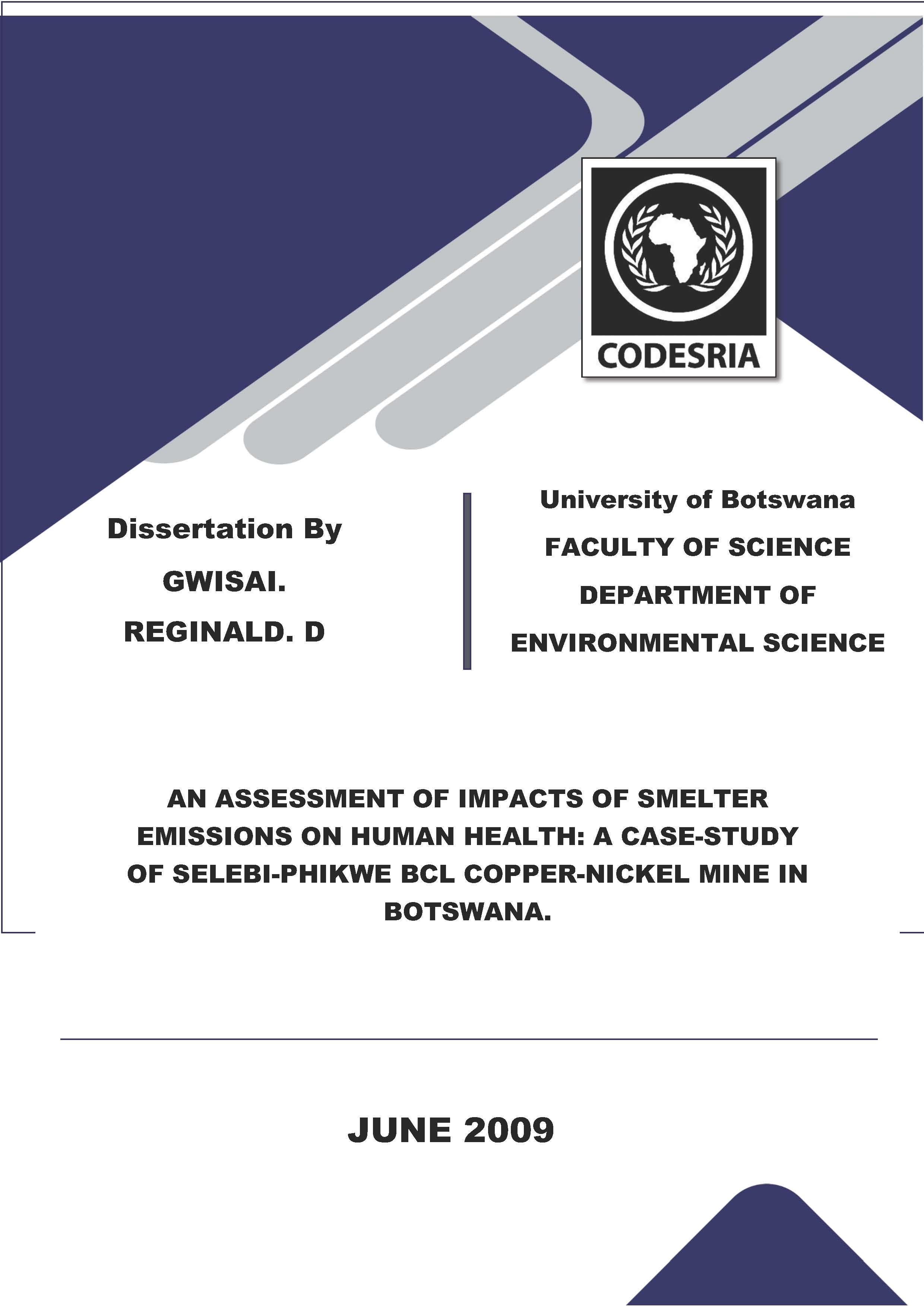AN ASSESSMENT OF IMPACTS OF SMELTER EMISSIONS ON HUMAN HEALTH: A CASE-STUDY OF SELEBI-PHIKWE BCL COPPER-NICKEL MINE IN BOTSWANA
Keywords:
HUMAN HEALTH, BOTSWANA, COPPER-NICKELSynopsis
The general objective of the study was to ascertain the relationship between smelter emissions and human health in and around Selebi-Phikwe. In Botswana BCL mine in Selebi-Phikwe is the leading producer of gaseous emissions in the country. The area of study consisted of locations in the town of Selebi-Phikwe and the surrounding villages, which were Mmadinare to the west, Bobonong and Tobane to the east, and Sefophe to the south. According to Ekosse (2004) there were high incidence rates of respiratory cases such as coughs and common colds recorded in the local health facilities. However it had not yet been shown that occurrence of respiratory diseases was due to smelter emissions from the mine. Therefore the undertaken study was to test the hypothesis whether there was a relationship between production of gaseous emissions from BCL copper-nickel
mine and respiratory case load relative to distance and direction of plume movement. This was in line with the recommendation made by Asare (1999), who suggested the need for a health impact research in Selebi-Phikwe. The undertaken project was conducted by means of a social survey whereby a household survey was conducted using systematic sampling and a formula by Yamane (1967:886) was used to calculate the sample size. Secondary data on respiratory related diseases in health facilities and key informant interviews were also key sources of information. Data collected was subjected to both qualitative and appropriate quantitative analysis tools.
Downloads
References
African Regional Implementation Review for the 14ᵗʰ Session of the Commission on Sustainable Development (CSD-14), (1992). Atmosphere and Air Pollution. United Nations Environment Programme (UNEP) on behalf of the Joint Secretariat UNECA, UNEP, UNIDO, UNDP, ADB and NEPAD Secretariat.
American Thoracic Society (ATS) (1996). ‘A committee of the environment and Occupational Health Assembly of the American Thoracic Society. State of the art Review: Health effects of outdoor air
pollution’ in American Review of Critical Care Medicine, vol 153, no 1, pp 33-50, and vol 153, no 2 pp 477-998.
Andrew R.W., and Jackson, J.M. (1996). Environmental Science: The Natural Environment and Human Impact. British Library Cataloguing in Publication Data.
Asare, B.K. (1999). Perceptions on Socio-Economic and Environmental Impacts of Mining in Botswana: A Case Study of Selibe-Phikwe Copper-Nickel Mine.
Atmospheric Resource Information Centre (ARIC) (1999). Air Quality and Acid Rain Fact Sheets, Manchester Metropolitan University. www.earthscape.org (14/06/09).
Babbie, E. (2004). The Practice of Social Research.Wadsworth, Canada.
Barzza-Villarreal, A., Sunyer, J., Hernandez-Cadena, I., Escamill-Nunez, M., Sienra- Monge, J.J.,
Ramirez-Aguilar, M., Cortez-Liyo, M., Holguin, F., Diaz-sanchez, D., Oliu, A.C., Romieu, I. (2008).
Air pollution, Airway Inflamation, and Lung Function in a Co- hort study of Mexico City School children. Environmental Health Persperctives. 116: 832-838 (2008).
Burnett, R.T., Thun, M.J., Calle, E.E., Krewski, D., Ito, K. (2002). Lung cancer, cardiopulmonary mortality, and long-term exposure to fine particulate air pollution. JAMA 287: 1132-1141.
Burnett, T. (2003), Sulphur Dioxide and Toxic Metal Emissions from Smelters in Ontario, Pollution Probe, February, 2003.
Boon, R., G. J., Alexaki, A., and Becerra, E.H., (2001). The ILo Clean Air Project: A local response to industrial pollution control in Peru, Environmental Urbanisation, 13(2), 215-232.
Botwana National Environmental Laboratory (BNEL) (2007), Country Fact Sheet, P/Bag BR 132, Gaborone, Botswana.
Briggs, D.J. (1995). Environmental Statistics for Environmental Policy: Data Genealogy and Quality. Journal of Environmental Management, 44: 35-52.
Elsom, D. (1975). Atmospheric Pollution: Cause, Effect and Control Policies Basil Blackwell Inc, New York, USA.
EPA (1996) ‘National Ambient Air Quality Standards for particulate matter: Proposed rule’ in Federal Register, vol 61, no 241, 40CFR part 50.
Evans, J., Wolff, S. (1996). “Modelling of Air pollution Impact,” In Richard Larson and John D Spangler (Ed.), Particles in Our Air: Concentrations of Health Effects, Harvard University Press: 191.
Frampton, M.W., Ghio, A.J., Samet, J.M., Carson, J.L., Carter, J.D., Devlin, R.B. (1999). Effects of aqueous extracts of PM₁₀ filters from the Utah Valley on human airway epithelial cells. Am. J. Physiol, 277(5 Pt 1):L960–L967.
Franek, W., Lou DeRose, J.D. (2003). Principles and Practices of Air Pollution Control, Student Manual, APTI course 452, Third Edition, New York, USA.
Garg, S. K. (1999a). Biology Research Unit, S.K., University. Dunka -814 101, India. Post Graduate Department of Zoology, Pollution Research Laboratory, Department of Zoology B.S.K College Barharwa-
, (Jharkhand), Khanna Publishers, New Delhi India.
Garg, S.K. (1999b). Sewage Disposal and Air Pollution Engineering: Environmental Engineering Volume
II, Khanna Publishers, New Delhi, India.
Gidhagen, L., Kahelin, H., Schmidt-Thome, P., and Johansson C. (2002). Anthropogenic and Natural Levels of Arsenic in PM10 in Central and Northen Chile, Atmos, Environ., 35, 115-1170.
Gillham, B. (2000). Developing a questionnaire, (Real World Research).London continuum,United Kingdom.
Ghio, A., Stonehuerner, J., Dailey, L., Carter, J.D. (1999). Metals associated with both the water-soluble and insoluble fractions of an ambient air pollution particle catalyze an oxidative stress. Inhal Toxicol, 11:37–49.
Godish, T. (1997). “Health Effects,” Air Quality, 3ʳᵈ Edition, Lewis, Publishers, New York, USA.
Government of Botswana, Department of Surveys and Mapping. (2002). Botswana National Atlas. Government publishing office, Gaborone.






